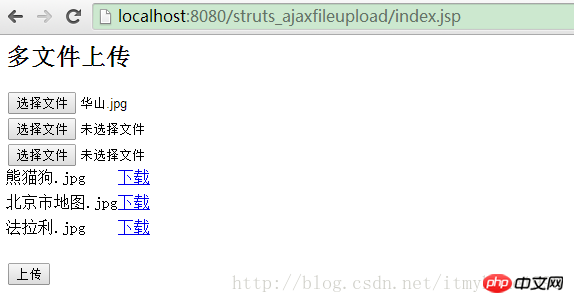Home >Backend Development >PHP Tutorial >Detailed example of Ajax's FileUpload and Struts2 implementing multi-file upload function
Detailed example of Ajax's FileUpload and Struts2 implementing multi-file upload function
- 小云云Original
- 2017-12-25 10:10:131739browse
单文件和多文件的实现区别主要修改两点,一是插件ajaxfileupload.js里接收file文件ID的方式,二是后台action是数组形式接收。本文主要介绍了AjaxFileUpload+Struts2实现多文件上传功能,需要的朋友可以参考下,希望能帮助到大家。
1、ajaxFileUpload文件下载地址http://www.phpletter.com/Demo/AjaxFileUpload-Demo/
2、引入jquery-1.8.0.min.js、ajaxFileUpload.js文件
3、文件上传页面核心代码
<body>
<form action="" enctype="multipart/form-data">
<h2>
多文件上传
</h2>
<input type="file" id="file1" name="file" />
</br>
<input type="file" id="file2" name="file" />
</br>
<input type="file" id="file3" name="file" />
</br>
<span>
<table id="down">
</table>
</span>
</br>
<input type="button" onclick="fileUpload();" value="上传">
</form>
</body>
<script type="text/javascript">
function fileUpload() {
var files = ['file1','file2','file3']; //将上传三个文件 ID 分别为file2,file2,file3
$.ajaxFileUpload( {
url : 'fileUploadAction', //用于文件上传的服务器端请求地址
secureuri : false, //一般设置为false
fileElementId : files, //文件上传的id属性 <input type="file" id="file" name="file" />
dataType : 'json', //返回值类型 一般设置为json
success : function(data, status) {
var fileNames = data.fileFileName; //返回的文件名
var filePaths = data.filePath; //返回的文件地址
for(var i=0;i<data.fileFileName.length;i++){
//将上传后的文件 添加到页面中 以进行下载
$("#down").after("<tr><td height='25'>"+fileNames[i]+
"</td><td><a href='downloadFile?downloadFilePath="+filePaths[i]+"'>下载</a></td></tr>")
}
}
})
}
</script>
以上fileElementId属性接收的files参数为['file1','file2','file3']
由于是多文件,所以我们需要修改ajaxfileupload.js 找到以下代码
var oldElement = jQuery('#' + fileElementId);
var newElement = jQuery(oldElement).clone();
jQuery(oldElement).attr('id', fileId);
jQuery(oldElement).before(newElement);
jQuery(oldElement).appendTo(form);
修改为:
for(var i in fileElementId){
var oldElement = jQuery('#' + fileElementId[i]);
var newElement = jQuery(oldElement).clone();
jQuery(oldElement).attr('id', fileId);
jQuery(oldElement).before(newElement);
jQuery(oldElement).appendTo(form);
}
4、文件上传Action
public class FileAction {
private File[] file; //文件
private String[] fileFileName; //文件名
private String[] filePath; //文件路径
private String downloadFilePath; //文件下载路径
private InputStream inputStream;
/**
* 文件上传
* @return
*/
public String fileUpload() {
String path = ServletActionContext.getServletContext().getRealPath("/upload");
File file = new File(path); // 判断文件夹是否存在,如果不存在则创建文件夹
if (!file.exists()) {
file.mkdir();
}
try {
if (this.file != null) {
File f[] = this.getFile();
filePath = new String[f.length];
for (int i = 0; i < f.length; i++) {
String fileName = java.util.UUID.randomUUID().toString(); // 采用时间+UUID的方式随即命名
String name = fileName + fileFileName[i].substring(fileFileName[i].lastIndexOf(".")); //保存在硬盘中的文件名
FileInputStream inputStream = new FileInputStream(f[i]);
FileOutputStream outputStream = new FileOutputStream(path+ "\\" + name);
byte[] buf = new byte[1024];
int length = 0;
while ((length = inputStream.read(buf)) != -1) {
outputStream.write(buf, 0, length);
}
inputStream.close();
outputStream.flush();
//文件保存的完整路径
// 如:D:\tomcat6\webapps\struts_ajaxfileupload\\upload\a0be14a1-f99e-4239-b54c-b37c3083134a.png
filePath[i] = path + "\\" + name;
}
}
} catch (Exception e) {
e.printStackTrace();
}
return "success";
}
/**
* 文件下载
* @return
*/
public String downloadFile() {
String path = downloadFilePath;
HttpServletResponse response = ServletActionContext.getResponse();
try {
// path是指欲下载的文件的路径。
File file = new File(path);
// 取得文件名。
String filename = file.getName();
// 以流的形式下载文件。
InputStream fis = new BufferedInputStream(new FileInputStream(path));
byte[] buffer = new byte[fis.available()];
fis.read(buffer);
fis.close();
// 清空response
response.reset();
// 设置response的Header
String filenameString = new String(filename.getBytes("gbk"),"iso-8859-1");
response.addHeader("Content-Disposition", "attachment;filename="+ filenameString);
response.addHeader("Content-Length", "" + file.length());
OutputStream toClient = new BufferedOutputStream(response.getOutputStream());
response.setContentType("application/octet-stream");
toClient.write(buffer);
toClient.flush();
toClient.close();
} catch (IOException ex) {
ex.printStackTrace();
}
return null;
}
/**
* 省略set get方法
*/
}5、struts配置
<!DOCTYPE struts PUBLIC
"-//Apache Software Foundation//DTD Struts Configuration 2.0//EN"
"http://struts.apache.org/dtds/struts-2.0.dtd">
<struts>
<package name="ajax_code" extends="json-default">
<!-- 文件上传 -->
<action name="fileUploadAction" class="com.itmyhome.FileAction" method="fileUpload">
<result type="json" name="success">
<param name="contentType">text/html</param>
</result>
</action>
</package>
<package name="jsp_code" extends="struts-default">
<!-- 文件下载 -->
<action name="downloadFile" class="com.itmyhome.FileAction" method="downloadFile">
<result type="stream">
<param name="contentType">application/octet-stream</param>
<param name="inputName">inputStream</param>
<param name="contentDisposition">attachment;filename=${fileName}</param>
<param name="bufferSize">4096</param>
</result>
</action>
</package>
</struts>
浏览器中输入:http://localhost:8080/struts_ajaxfileupload/index.jsp 即可进行文件上传
如图:

相关推荐:
ajaxfileupload.js上传文件后调用error函数该如何处理
The above is the detailed content of Detailed example of Ajax's FileUpload and Struts2 implementing multi-file upload function. For more information, please follow other related articles on the PHP Chinese website!

